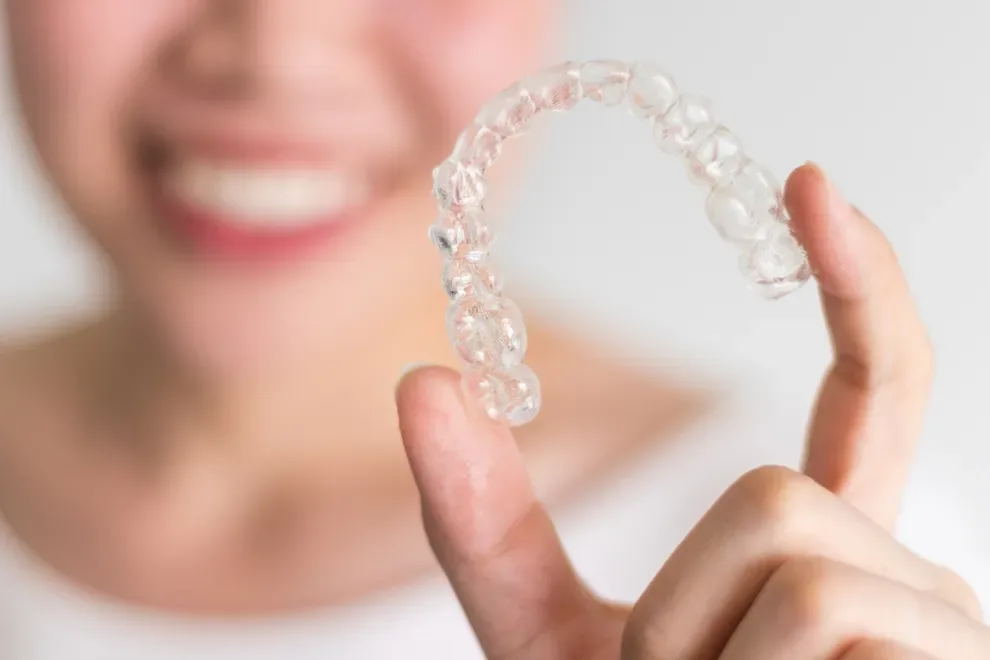How Do Aligners Work to Straighten Teeth?

Table of Contents
- How Aligners Straighten Teeth
- Are All Aligners the Same?
- Effectiveness of Different Aligners
- Aligners vs. Braces
At-home clear teeth aligners are more popular than ever before, and it’s easy to see why. Today’s top mail-order aligner providers offer fast results, straightforward and affordable pricing, and the ultimate in convenience.
Clear aligners can be removed as needed, allowing people more flexibility than any other teeth straightening option. And some companies offer a completely mail-order experience, with user-friendly impression kits and remote dentist monitoring eliminating the need for any in-person office visits.
While these at-home options offer an appealing alternative to braces, many interested consumers are still unsure of how they work. Can an effective treatment plan really be completed with these simple-looking clear teeth aligners? Is it possible to do this without even visiting a dentist?
For most people looking to correct a mild-to-moderate smile issue, the answer is yes. By taking a comprehensive initial scan or impression of your teeth, aligner providers are able to get a clear picture of where your teeth are and where they need to go in order to get your ideal smile.
A series of aligners is then designed to move your teeth, gradually throughout treatment, into their desired locations. The process is easy from start to finish, and you end up with a straight, healthy smile.
Know that individual results can vary significantly. Factors like your oral health, your compliance with the treatment plan, and the severity of your alignment problems all play a role. Sometimes, aligners just aren’t the best choice. A responsible partner will explain the pros and cons in relation to your situation and help you decide.
How Do Aligners Straighten Your Teeth?
Using your initial scan or impressions, the aligner provider (using their technology and supervising dentist and orthodontists) is able to determine your ideal smile.
A series of clear aligners is then produced to take your teeth from their current position (the starting point) to their desired position (the planned ideal smile). Each aligner tray is worn for a week or two as they move your teeth to follow the planned straightening process.
The aligners apply pressure not to one or two “problematic” teeth, but to all of your teeth at once. This pressure applied continuously (most aligners are prescribed to be worn as much as possible, ideally 22 hours a day) repositions teeth over the course of the treatment.
When aligners press on your teeth, they trigger a series of physical reactions. Your teeth, the supporting ligaments, and the underlying bone sense the pressure and respond by breaking down bone in front of the moving tooth and depositing more bone behind it. The result is a tooth in a new position, supported by fresh tissue.
Are All Aligners the Same?
While the most popular at-home aligner providers on the market today use the same basic principles in their treatment and aligner design, aligner providers may differ in the product or treatment they offer. You can also experience better service with some providers, making the entire process easier and more enjoyable.
Differences in mail-order aligners may include the following.
| Materials | Fit | Technology |
Byte | BPA-free, transparent, medical-grade polymer | Comfort cut | At-home treatment |
ALIGNERCO | Transparent polymer | Handcrafted and trimmed to the gum line | At-home treatment |
SmileDirectClub (no longer in business) | BPA-free plastic | Precision cut | In-person 3D scans are required; no office visits needed during treatment |
Candid | BPA- and phthalate-free plastic | Quality checked, but rough edges are not uncommon | At-home treatment |
NewSmile | Clear, durable plastic | Cut straight across | At-home treatment |
SnapCorrect | Medical-grade plastic free of BPA or latex | Trimmed to the gum line | At-home treatment |
Strayt | Clear, medical grade, thermoplastic polymer | Scalloped to follow the gum line | In-person scan, at-home treatment |
Invisalign | Medical-grade thermoplastic polymer | Cut straight across | In-person treatment by a dentist |
ClearCorrect | Polyurethane resin plastic that is BPA-free | Cut straight across | In-person treatment by a dentist |
Material
While the top aligner providers on the market all use smooth plastic for their production, they may vary in thickness and type. At Byte, for example, our material is a BPA-free, highly transparent, medical-grade polymer film that’s both high-impact and resistant to tears and damage.
Fit
How your aligners fit on your mouth can make all the difference in your day-to-day comfort. While all aligners are designed to apply pressure in order to promote proper tooth movement, it’s also important that they’re comfortable to wear during your everyday activities. After all, for best results, you will be wearing them for at least 22 hours a day.
Today’s top aligners use cutting-edge technology to provide a smooth fit, but providers may vary in how they cut and product their aligners. SmileDirectClub, for example, touts their laser-cut aligners with Comfort Sense technology, while ALIGNERCO claims their aligners are hand-crafted and trimmed close to the gums for comfort.
Convenience
While some providers (like Candid) require an in-office scan to begin treatment, others like Byte and ALIGNERCO offer a completely at-home experience with easy-to-use impression kits that will determine if you’re a candidate for mail-order aligners.
Pricing & Guarantees
Many of the top clear aligner options offer straightforward pricing and easy payment plans as well as guarantees on their services.
At Byte, for example, we offer our Byte for Life guarantee program, ensuring that if your teeth shift after prescribed treatment, you’ll be eligible for a new set of aligner treatment trays. SmileDirectClub also offers a guarantee for approved issues after treatment if the patient meets certain requirements.
Other at-home aligner companies may only offer a warranty on retainers, which must be purchased separately. For providers offering a hybrid of at-home and in-office treatment, pricing and guarantees may be more complicated if they are handled by the approved dentist or orthodontic professional rather than the aligner company.
Are Some Aligners More Effective?
Each patient enters aligner treatment with different smile issues and expectations. Different mouths may react differently to aligner treatment. These factors, along with the fact that aligner providers use the same basic principles of pressure and treatment design, make it hard to determine which aligners are more effective than others.
However, looking at people’s shared experiences with aligner providers can provide some insight into their effectiveness as well as the level of service you can expect from them. Looking at their average treatment time can also be helpful.
Some companies may also include accessories in their aligner kit to improve the comfort and performance of their aligner trays. Byte, for example, includes our HyperByte high-frequency vibrational device in their aligner kit. Research indicates that devices like these have been shown to increase comfort and improve aligner effectiveness.
Aligners vs. Braces
When considering orthodontic treatment, many first think of traditional metal braces. For many years, braces were the only option available to those looking to fix their bite or smile.
So, how do aligners compare to metal braces?
The American Association of Orthodontists (AAO) says one appliance isn’t automatically better than another. The right choice depends on a person’s goals and lifestyle. However, the AAO says aligners are best for correcting issues considered mild or moderate. Severe problems are better addressed with braces.
Advantages of Aligners
Aligners are generally more affordable than braces. The price of braces, on average, starts at around $5,300 and may cost much more, depending on the complexity of treatment and the type of braces used. For example, ceramic and lingual braces are more expensive options than traditional metal braces. With insurance coverage, the cost of braces may start at around $3,400. The top aligners on the market range from around $1,900 to $3,000.
Aligners are much more convenient than braces. Braces require many in-office adjustments and checkups, while some aligners only require an initial in-office consultation. Some mail-order aligners offer a completely at-home experience with home impression kits and remote check-ins.
Aligners can be removed. While braces require installed hardware in the mouth, aligner trays can easily be removed for eating and special events. This again makes them more convenient, and it also makes maintenance and hygiene easier.
Clear aligners are much less visible than traditional braces.
Aligner treatment is generally faster than most braces treatment plans.
While aligners are an easy choice for many, some may still prefer (or need) braces.
Advantages of Braces
While most people with mild or moderate bite issues are good candidates for aligner treatment, those with more complex orthodontic issues or certain oral health conditions may require braces.
In order to work, aligners must be worn as prescribed. Patients who lack the discipline to wear aligners as prescribed may get better results from braces, as they won’t have the option of removing them.
Patents who prefer the ongoing, in-person support of an orthodontist may prefer the braces treatment process.
Ultimately, at-home aligners work well for most people with mild to moderate alignment issues. Some people with more severe misalignments may need braces, but if you are a candidate for aligners, you will generally get faster and less expensive treatment with aligners.
You can find out if you are a candidate via an at-home impression kit today.
How Does At-Home Monitoring Work?
Some aligners, including Byte, allow you to skip in-person appointments and follow a doctor-designed treatment plan at home. While you’re not wasting time in waiting rooms, you aren’t left to manage your care independently. At-home aligners come with plenty of support.
When your impressions are approved, your team will send you aligner trays packaged with plenty of instructions. You’ll know how to put them in, take them out, clean them, and change them. You’ll also know how long you should wear them every day.
Companies like Byte use an online portal to stay in touch with patients. You’ll log into the site to see what your smile will look like at each stage of treatment. If you have questions, get the support you need from experts in that portal.
Once per month, you’ll log into the portal for a virtual check-in assessment. You’ll answer a few questions about your teeth and upload photos of your smile so your team can check your progress. If anything isn’t quite right, your team will contact you or send new trays that can get you back on track.
This system allows you to stay in close contact with your treatment team in the quickest and most efficient way possible. A doctor is always in charge of your care.
